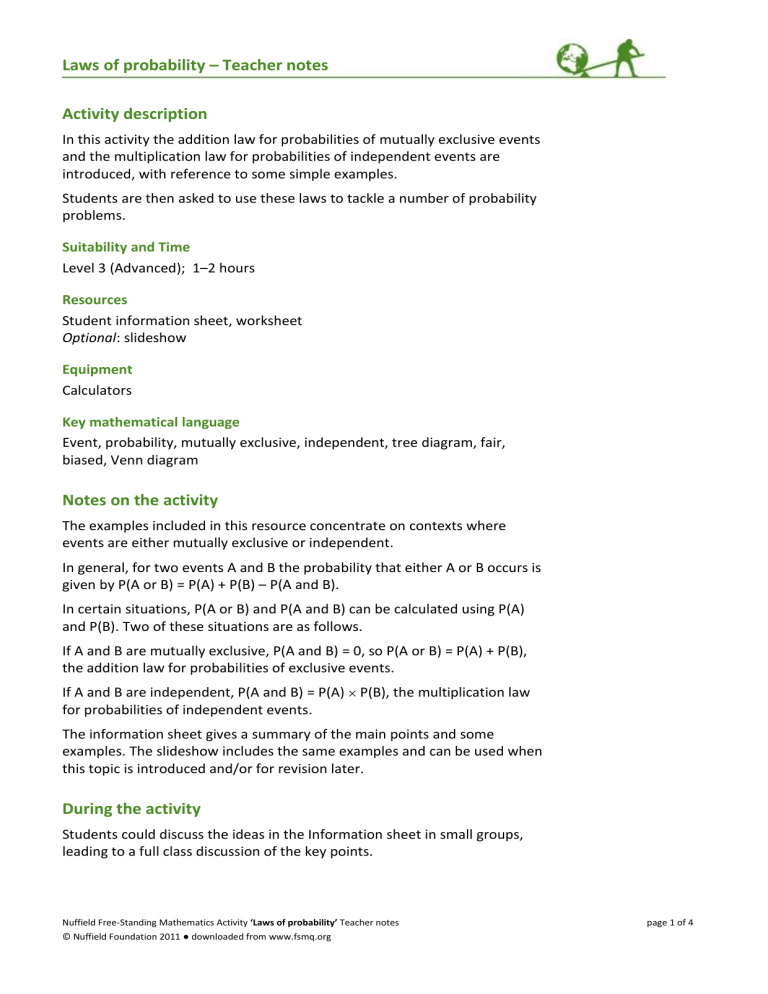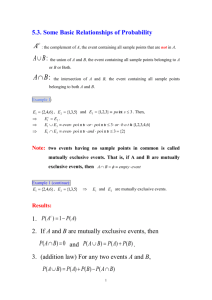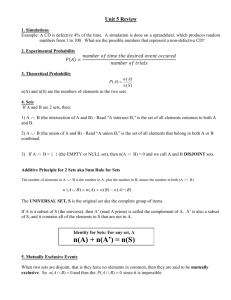Teacher notes Word

Laws of probability – Teacher notes
Activity description
In this activity the addition law for probabilities of mutually exclusive events and the multiplication law for probabilities of independent events are introduced, with reference to some simple examples.
Students are then asked to use these laws to tackle a number of probability problems.
Suitability and Time
Level 3 (Advanced); 1–2 hours
Resources
Student information sheet, worksheet
Optional: slideshow
Equipment
Calculators
Key mathematical language
Event, probability, mutually exclusive, independent, tree diagram, fair, biased, Venn diagram
Notes on the activity
The examples included in this resource concentrate on contexts where events are either mutually exclusive or independent.
In general, for two events A and B the probability that either A or B occurs is given by P(A or B) = P(A) + P(B) – P(A and B).
In certain situations, P(A or B) and P(A and B) can be calculated using P(A) and P(B). Two of these situations are as follows.
If A and B are mutually exclusive, P(A and B) = 0, so P(A or B) = P(A) + P(B), the addition law for probabilities of exclusive events.
If A and B are independent, P(A and B) = P(A) P(B), the multiplication law for probabilities of independent events.
The information sheet gives a summary of the main points and some examples. The slideshow includes the same examples and can be used when this topic is introduced and/or for revision later.
During the activity
Students could discuss the ideas in the Information sheet in small groups, leading to a full class discussion of the key points.
Nuffield Free-Standing Mathematics Activity ‘Laws of probability’ Teacher notes
© Nuffield Foundation 2011 ● downloaded from www.fsmq.org page 1 of 4
As an alternative, if students are familiar with the ideas of independence and being mutually exclusive, the tree diagram in the example of the biased coin could be used to motivate a discussion of how the probabilities have been calculated, and how the ideas of independence and being mutually exclusive have been used.
Points for discussion
As well as performing the necessary calculations, students should be encouraged to think about how they have used the basic laws of probability in solving the problems.
This should include considering whether or not the assumption of mutual exclusivity or independence can be justified.
Extensions
The suggested extension requires students to work backwards from the probability of two combined events to the probability of a single event. In both parts of the question there are a number of ways of tackling the problem; some students may find a quick method of solving the second part of the problem. As with the main set of questions, students should be encouraged to think about how they have used the basic laws of probability.
Answers to questions
1 Mutually exclusive events
Angela goes for her train to work:
Event A: she catches the train
Event B: she misses the train
Rory throws a dice:
Event A: he gets an odd number
Event B: he gets less than 4
Rory throws a dice:
Event A: he gets more than 3
Event B: he gets less than 3
Sue takes a card at random from a pack of 52:
Event A: she gets a spade
Event B: she gets a club
Sue takes a card at random from a pack of 52:
Event A: she gets a spade
Event B: she gets a queen
Mutually exclusive?
Yes No
Nuffield Free-Standing Mathematics Activity ‘Laws of probability’ Teacher notes
© Nuffield Foundation 2011 ● downloaded from www.fsmq.org page 2 of 4
2 Buttons
1 a
9
3 b
9
1
=
3
5 c
9
4 d
9
8 e
9
6 f
9
=
2
3
3 Independent events – tossing a coin a
1
2
1
6
1
=
12 b
1
2
1
2
1
=
4 c
1
2
2
6
=
1
6
4 Deliveries a
9 b i
16
1 ii
16
5 Potting bulbs a b i 0.512 ii 0.008 iii 0.896
1 st bulb
0.8
0.2 p a t r s i
F a g c k e
1
4
…
.
3
4
…
.
F
Delivered next day
Not delivered next day
2 nd bulb
0.8
0.2 k a a c g e p n d c o
S e
1
4
…
.
3
4
…
.
1
4
…
.
3
4
…
.
3 rd bulb
0.8
F
0.2
Delivered next day
Not delivered next day
Delivered next day
Not delivered next day
F 0.512
NF 0.128
0.8
F 0.128
NF
0.2
NF 0.032
0.8 F 0.128
NF
0.8
0.2
F
NF
0.2
0.8
0.2
NF 0.032
F 0.032
NF 0.008
Nuffield Free-Standing Mathematics Activity ‘Laws of probability’ Teacher notes
© Nuffield Foundation 2011 ● downloaded from www.fsmq.org page 3 of 4
6 Traffic lights a
First set of lights
1
3
Has to stop
2
3
Does not have to stop
Second set of lights
2
5
Has to stop
3
5
2
5
3
5
Does not have to stop
Has to stop
Does not have to stop
2 b i
15
2 ii
5 c 132
Answers to extension questions
P(Head on one toss) = 3
5
or 0.6
P(at least one Head on three tosses) =
117
125
or 0.936
Nuffield Free-Standing Mathematics Activity ‘Laws of probability’ Teacher notes
© Nuffield Foundation 2011 ● downloaded from www.fsmq.org page 4 of 4










